Keeping a Senior Cat Active and Healthy
Posted: 09/14/2022 | BY: Erin Cain | Categories: Behavior , Cat , Pet care , Top Tips
It can be tough to see our furry friends age, but thankfully there are things we can do to help them stay happy and healthy. This blog post will discuss what pet parents can do to keep their senior cat healthy and able. Senior cats tend to slow down as they get older, so it’s important to make sure your aging cat has plenty of opportunities to move around and play. You can also help by providing them with a nutritious diet and regular vet check-ups. With a little bit of TLC, your feline friend can live out his golden years in comfort and happiness.

When is a cat considered senior?
Cats used to be considered senior cats when they were around eight years old. However, today’s veterinarians see feline patients well into their twenties. Thanks to improved nutrition and living indoors, and advances in veterinary medicine, cats live longer than ever before. Most veterinarians think of felines as geriatric cats between 12 and 14 years old. But some aging cats begin to experience age-related physical and mental challenges during years 7 to 10, and most exhibit those signs after 12.
Unfortunately, many elderly cats suffer from degenerative joint disease and arthritis, two forces that wreak havoc on a cat’s body at this time. That said, cats can still enjoy their golden years by staying physically active, keeping them mentally stimulated.
As they grow older, a cat’s behavior may change as he becomes less active and playful. Cats may sleep more, often lose or gain weight, and have mobility issues that make it difficult to jump or climb up to their favorite cubby or window sill. It is essential to ensure your cat has easy access and interaction with the things that please them. Here are some care tips for keeping your senior cat happy and healthy during the latter part of his life.
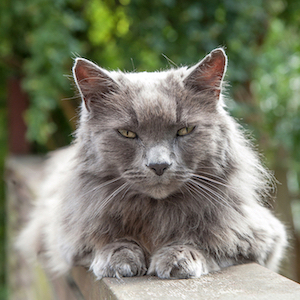
Provide adjustments for your senior cat.
As cats age, they begin to have limitations on their mobility. That high perch on top of the bookshelf in the family room isn’t so easy to reach. Cats are instinctually particular about the high places they go to sleep, relax, and destress. The inability to access those locations anymore can cause anxiety.
Encourage your cat to keep climbing for his favorite spot, but give him some assistance along the way with a set of small pet stairs designed for cats. Also, consider moving his favorite beds and litter boxes to places he can get to without much difficulty.
Make adjustments with your cat’s favorite toys, too. Mature cats may not have the “get up and go” that they did when they were younger, but many older cats still engage eagerly in play. If you want to get your cat moving and playing again, try these tips: with wand and string toys, move more slowly, play at ground level, or focus on a low area with occasional jumps as your cat’s mobility allows for it.
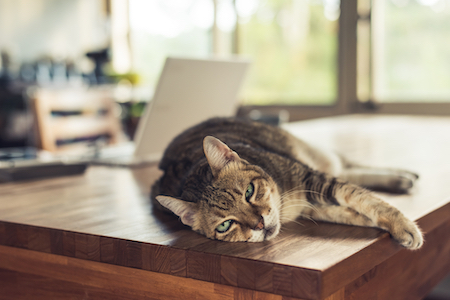
Combine playtime with low-level exercise.
Cats are great multitaskers when they’re younger cats. Still, as time goes on and coordination decreases with age, it may be more difficult for your cat to pursue its prey toy the way that he once did. The good news is that you can keep your senior cat moving and flexible by changing how you interact with him and his toys. Keep it simple and focus on one essential move at a time. To start, help your cat practice and strengthen his balance, which is a vital exercise to work on.
For example, to let your cat practice his balancing skills, place a stationary toy on the top of a couch, chair, or counter. Let your cat bat and knock it off the surface rather than making him have to jump and balance simultaneously. Instead of waving wand toys up and over your cat’s back, place them in an area where he can bat the toys for food rewards. This action will make balancing more exciting while keeping your cat safe and stimulating his mind.
Don’t forget to give your cat some rest breaks to savor the victory he has earned by catching his “prey.”
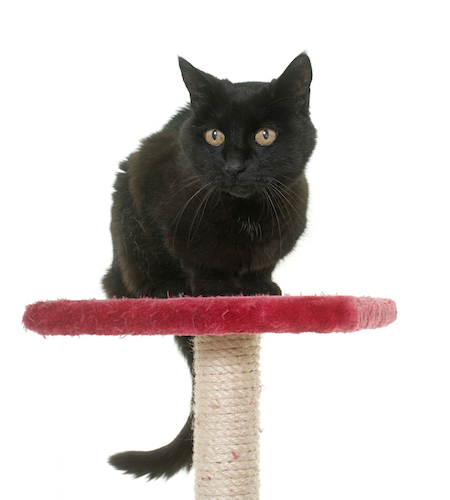
Offer lots of scratching options.
Scratching is a crucial part of cats’ daily life. They use it to stretch and strengthen the muscles in their toes, feet, legs, and other parts of the body, such as the back and shoulders. Having multiple scratching pads around the house is a great way to keep your older cat active, stimulated, and happy.
Help your old cat out and place some scratching pads or posts in the areas your cat loves to hang out. The options will have him moving from scratcher to scratcher, allowing him to exercise various muscles.
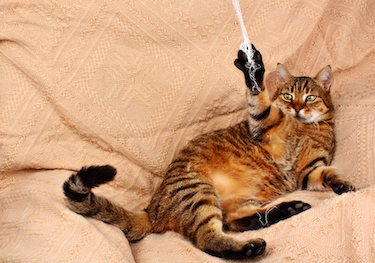
Encourage activities that don’t require much movement.
There are plenty of ways to keep your cat’s mind stimulated without requiring that they move more than usual. Enrichment involves the mind as well as the body. Cats love playing with boxes, no matter their age, so take a cardboard box, cut holes in it, and let your cat investigate and crawl inside of it. Crumple up some brown packing paper, sprinkle it with catnip or throw some catnip toys in it, and set it on the floor so your elderly cat can roll around and have fun.
Try a ball and track toy, which lets cats swat the toy and engage in play from a primarily stationary position. Aging senior cats will find a new lease on life with battery-powered toys that move under fabric covers or spin around fixed pedestals. With these toys, older cats can still use their eyes and ears to “hunt” without running around as much.
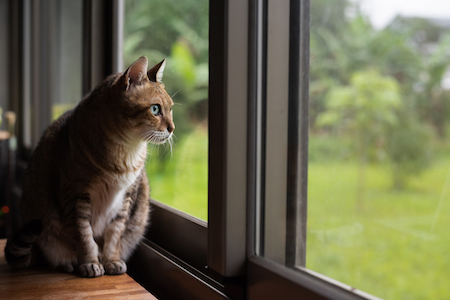
Keep your senior cat’s mind engaged.
You can still keep your cat mentally fit even if he no longer possesses the mobility to move physically. Training with elementary, low-movement commands like touching a target using only their nose or raising one paw when asked requires little to no movement. Keep your cat focused on what you are asking of him.
Arouse your cat’s curiosity with bird watching. Hang up a feeder outside an easily accessible window, so they can rest, relax, and watch the birds’ activities. No room for a bird feeder? No worries. Put on a streaming channel or video designed for cats featuring birds, squirrels, or other prey in which cats are interested. Your older cat’s brain will be whirring while watching other animals’ actions.
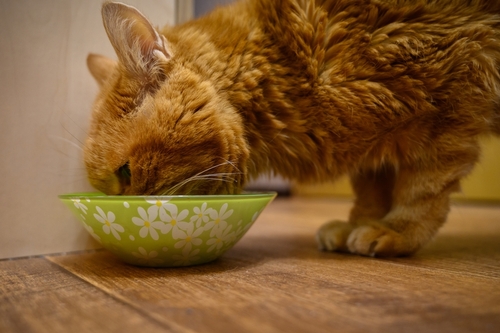
Check your cat’s diet.
A cat’s metabolism begins to slow around seven years old, resulting in the cat being less active. That’s when the proper diet for old cats makes all the difference in providing felines with all the nutrients they need. Those vitamins and minerals give the cat energy, something that the body can no longer produce at peak levels. A cat’s food can make all the difference between an older cat who acts his age and one who is energetic enough to keep up with the kittens.
Senior cat food is specially formulated for older cats that have difficulty digesting and absorbing fat. It’s crucial to provide your senior feline with high-quality protein, vitamins, minerals, digestible carbohydrates, fatty acids, and antioxidants. Aging cats may have difficulty digesting and absorbing fats. Hence, they need a healthier fat source in their food which will also be easier on the digestive system.
Feeding older cats the best diet can help them maintain their health and optimum body weight. Proper food helps older cats retain steady energy levels and slow or stop the development of chronic disease. The right food ensures that your cat doesn’t experience drastic weight changes. Speak with your cat’s veterinarian about the best senior cat food for your cat’s individual needs.
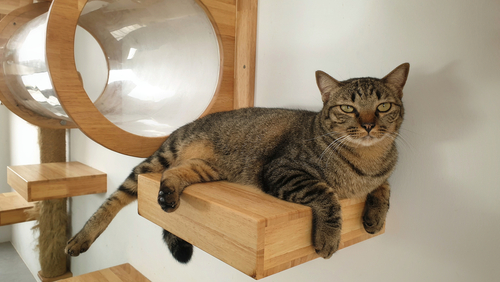
Keep your senior cat healthy with pet insurance.
Advanced age is no excuse for senior cats to be without a pet health insurance plan. Many providers offer policies for aging pets depending on your pet’s needs and circumstances, including life expectancy and what health issues and conditions are covered. Pet Insurance Review will find the best plans available for your older cat. Fill out a free quote for your cat, then go bond with your kitty while we do the hard work for you. Protect your older pet. He will thank you for it in the future!
References:
- Cornell Feline Health Center. (2016). Loving Care for Older Cats. Retrieved from https://www.vet.cornell.edu/departments-centers-and-institutes/cornell-feline-health-center/health-information/feline-health-topics/loving-care-older-cats
- Veazie Veterinary Clinic. (n.d.). Signs of Aging. Retrieved from https://www.veazievet.com/feline-wellness/senior-cat-health/signs-of-aging/
- Jones, O. (2022). 10 Best Steps for Cats With Arthritis in 2022. Retrieved from https://www.hepper.com/best-steps-for-cats-with-arthritis/
- Anderson, K. (2021). Give Your Senior Kitty a Paw Up With These Cat Trees for Older Cats. Retrieved from https://www.rover.com/blog/cat-trees-for-older-cats/
- Bates, A. (2022). 10 Best Toys for Older Cats in 2022. Retrieved from https://petkeen.com/best-toys-for-older-cats/
- Cerulli, P. (2021). 5 engaging YouTube channels to entertain your lonely cat. Retrieved from https://www.pawtracks.com/cats/youtube-channels-cats/
- Williams, K., Downing, R. (2022). Feeding Mature, Senior, and Geriatric Cats. Retrieved from https://vcahospitals.com/know-your-pet/feeding-mature-senior-and-geriatric-cats
The information contained on this blog is intended for informational and educational purposes only and should not be construed as medical advice. It is not a substitute for professional veterinary care. Always consult with your veterinarian before making any changes to your pet's health care or treatment plan.
The authors of this blog are not veterinarians and do not claim to be experts in pet health. The information provided here is based on our own experiences and research, as well as information from reputable sources. However, we cannot guarantee the accuracy or completeness of this information.
We encourage you to do your own research and consult with your veterinarian before making any decisions about your pet's health.
Previous post
Make Moving With Your Dog EasierNext post
Pets and Anesthesia: What to KnowCompare top pet insurance providers & plans.
